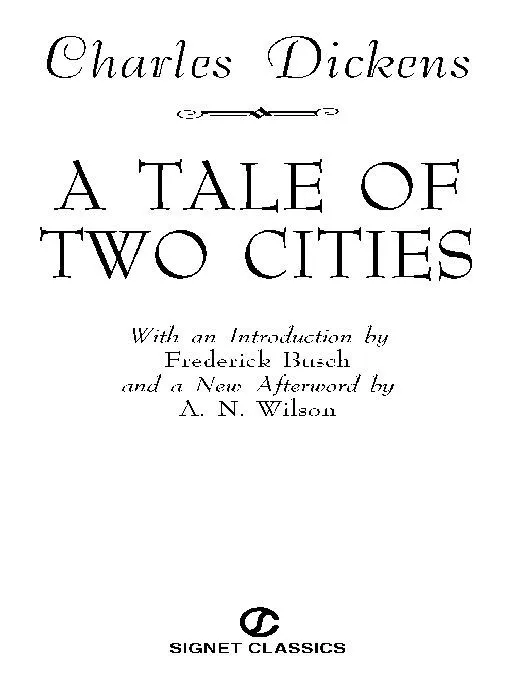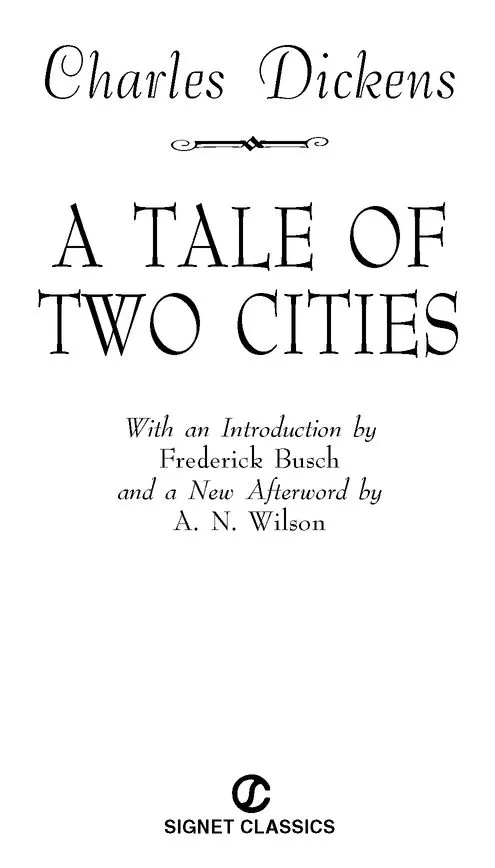A Tale of Two Cities

Table of Contents
Title Page
Copyright Page
Dedication
Introduction
PREFACE TO
BOOK THE FIRST - Recalled to Life
Chapter 1 - The Period
Chapter 2 - The Mail
Chapter 3 - The Night Shadows
Chapter 4 - The Preparation
Chapter 5 - The Wine-Shop
Chapter 6 - The Shoemaker
BOOK THE SECOND - The Golden Thread
Chapter 1 - Five Years Later
Chapter 2 - A Sight
Chapter 3 - A Disappointment
Chapter 4 - Congratulatory
Chapter 5 - The Jackal
Chapter 6 - Hundreds of People
Chapter 7 - Monseigneur in Town
Chapter 8 - Monseigneur in the Country
Chapter 9 - The Gorgon’s Head
Chapter 10 - Two Promises
Chapter 11 - A Companion Picture
Chapter 12 - The Fellow of Delicacy
Chapter 13 - The Fellow of No Delicacy
Chapter 14 - The Honest Tradesman
Chapter 15 - Knitting
Chapter 16 - Still Knitting
Chapter 17 - One Night
Chapter 18 - Nine Days
Chapter 19 - An Opinion
Chapter 20 - A Plea
Chapter 21 - Echoing Footsteps
Chapter 22 - The Sea Still Rises
Chapter 23 - Fire Rises
Chapter 24 - Drawn to the Loadstone Rock
BOOK THE THIRD - The Track of a Storm
Chapter 1 - In Secret
Chapter 2 - The Grindstone
Chapter 3 - The Shadow
Chapter 4 - Calm in Storm
Chapter 5 - The Wood-Sawyer
Chapter 6 - Triumph
Chapter 7 - A Knock at the Door
Chapter 8 - A Hand at Cards
Chapter 9 - The Game Made
Chapter 10 - The Substance of the Shadow
Chapter 11 - Dusk
Chapter 12 - Darkness
Chapter 13 - Fifty-two
Chapter 14 - The Knitting Done
Chapter 15 - The Footsteps Die Out For Ever
AFTERWORD
SELECTED BIBLIOGRAPHY
As a child, Charles Dickens (1812-70) came to know not only hunger and privation, but also the horror of the infamous debtors’ prison and the evils of child labor. A surprise legacy brought release from the nightmare of prison and “slave” factories and afforded Dickens the opportunity of two years’ formal schooling. He taught himself shorthand and worked as a parliamentary reporter until his writing career took off with the publication of Sketches by Boz (1836) and The Pickwick Papers (1837). As a novelist and magazine editor, Dickens had a long run of serialized success through Our Mutual Friend (1864-65). In later years, ill health slowed him down, but he continued his popular dramatic readings from his fiction to an adoring public, which included Queen Victoria. At his death, The Mystery of Edwin Drood remained unfinished.
Distinguished writer, teacher, and critic Frederick Busch is the author of more than twenty works of fiction, including North, Girls, and The Mutual Friend, a novel about Charles Dickens.
A. N. Wilson was born in 1950 and educated at Rugby and New College, Oxford. A Fellow of the Royal Society of Literature, he has held a prominent position in the world of literature and journalism. Among his acclaimed biographies are Lives of Sir Walter Scott (John Llewellyn Rhys Prize), Tolstoy (Whitbread Award for Biography), C. S. Lewis, Hilaire Belloc, and Iris Murdoch. The Victorians, his study of the Victorian Age, and its sequel, After the Victorians, were both published to the widest critical acclaim, and he is the award-winning author of such novels as My Name Is Legion and The Healing Art.

SIGNET CLASSICS
Published by New American Library, a division of
Penguin Group (USA) Inc., 375 Hudson Street,
New York, New York 10014, USA
Penguin Group (Canada), 90 Eglinton Avenue East, Suite 700, Toronto,
Ontario M4P 2Y3, Canada (a division of Pearson Penguin Canada Inc.)
Penguin Books Ltd., 80 Strand, London WC2R 0RL, England
Penguin Ireland, 25 St. Stephen’s Green, Dublin 2,
Ireland (a division of Penguin Books Ltd.)
Penguin Group (Australia), 250 Camberwell Road, Camberwell, Victoria 3124,
Australia (a division of Pearson Australia Group Pty. Ltd.)
Penguin Books India Pvt. Ltd., 11 Community Centre, Panchsheel Park,
New Delhi - 110 017, India
Penguin Group (NZ), cnr Airborne and Rosedale Roads, Albany,
Auckland 1310, New Zealand (a division of Pearson New Zealand Ltd.)
Penguin Books (South Africa) (Pty.) Ltd., 24 Sturdee Avenue,
Rosebank, Johannesburg 2196, South Africa
Penguin Books Ltd., Registered Offices:
80 Strand, London WC2R 0RL, England
Published by Signet Classics, an imprint of New American Library,
a division of Penguin Group (USA) Inc.
First Signet Classics Printing, February 1960
First Signet Classics Printing (Wilson Afterword), February 2007
Introduction copyright © Frederick Busch, 1997
Afterword copyright © A. N. Wilson, 2007
All rights reserved
eISBN : 978-1-101-04367-7
 REGISTERED TRADEMARK—MARCA REGISTRADA
REGISTERED TRADEMARK—MARCA REGISTRADA
The scanning, uploading, and distribution of this book via the Internet or via any other means without the permission of the publisher is illegal and punishable by law. Please purchase only authorized electronic editions, and do not participate in or encourage electronic piracy of copyrighted materials. Your support of the author’s rights is appreciated.
http://us.penguingroup.com
THIS TALE IS INSCRIBED
TO THE
LORD JOHN RUSSELL
IN REMEMBRANCE OF
MANY PUBLIC SERVICES AND
PRIVATE KINDNESSES
INTRODUCTION:
THE MEASURE OF SEPARATENESS
Although most first readers of A Tale of Two Cities know its rough outlines—the father locked away in the Bastille, the beautiful, dutiful daughter who helps him to find comfort once he is released, the frenzied slaughter of the revolution, Carton the Gothic hero, handsomely imperfect, who finds real life in his sacrificial death (the “far, far better thing that I do . . .” under the blade of the Guillotine)—these readers might believe that they are opening the pages of a political or, say, historical novel. Its title sounds geographical, as if the novel were about size and distance. Like most of Dickens’ novels, it begins in the past, so it seems to be concerned with history. And the first words intoned by the narrative voice make up that famous sentence about the times, the age, the epoch, the season, and the fate of people in general—the “we” who regarded life as either bleak or salvational. Royalty is speared on the nib of Dickens’ pen—“a king with a large jaw and a queen with a plain face”—and Dickens swats at the governing bodies in Paris and London. He then tightens his focus, from the fate of all humankind to the fate of the characters in his novel. And then, tightening further, he conjures Jarvis Lorry who, as his last name suggests, is to be a vehicle for the conveyance of characters and plot between England and France.
But to Dickens, all life is domestic, no matter on what scale he writes it, and no matter its political or historical context. As with all his work, the novel begins in him. And we can see it in the privacies of his writing notes and the intimacies of his emotional life.
1 comment